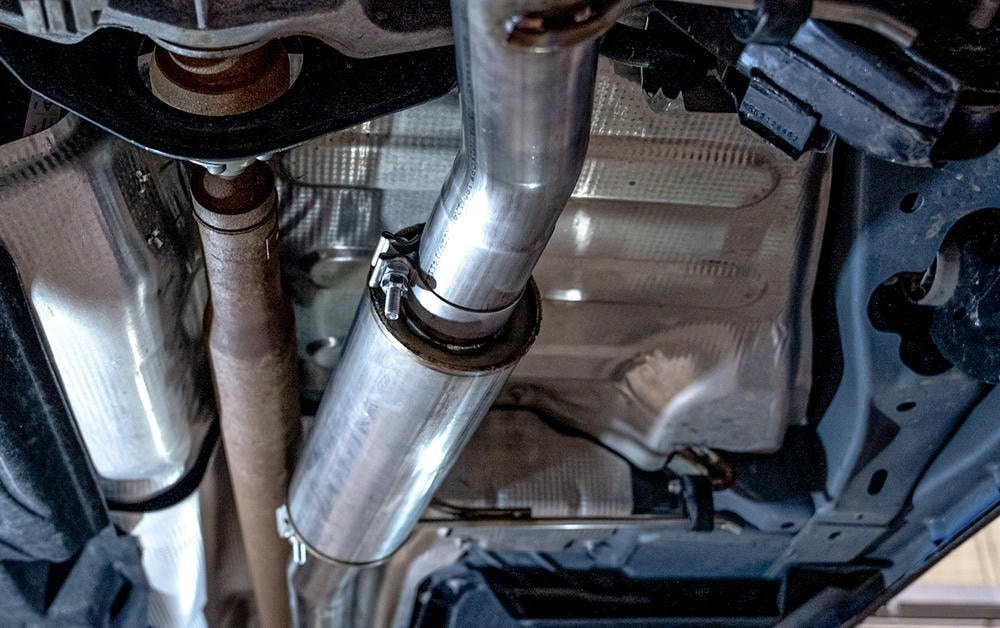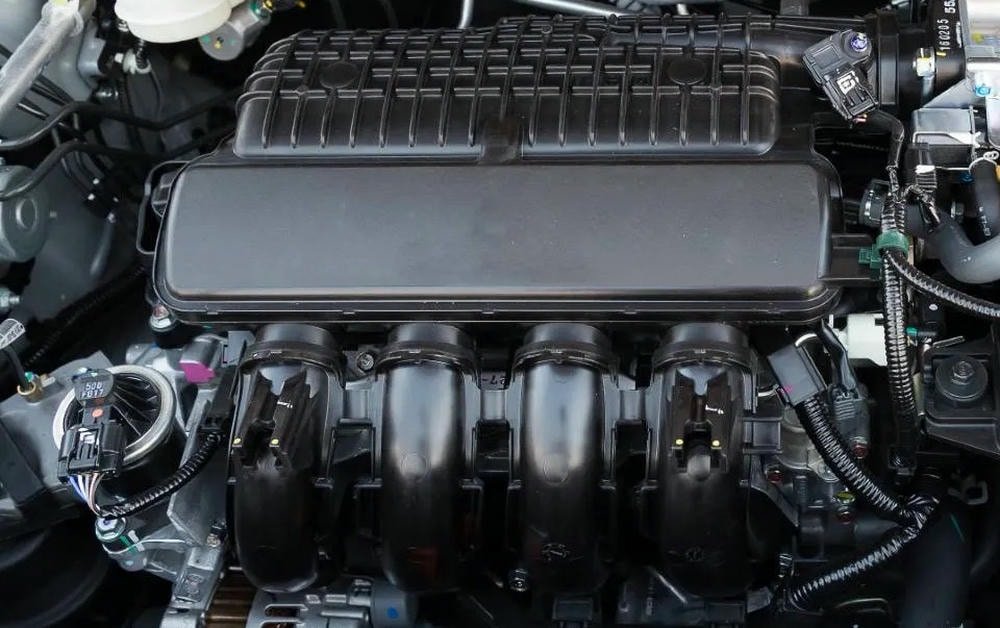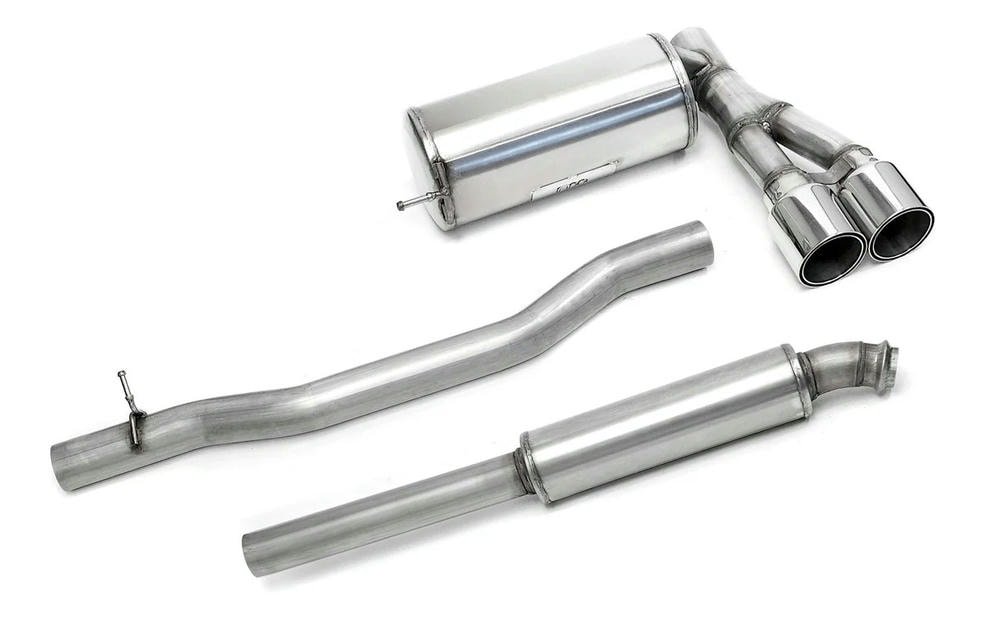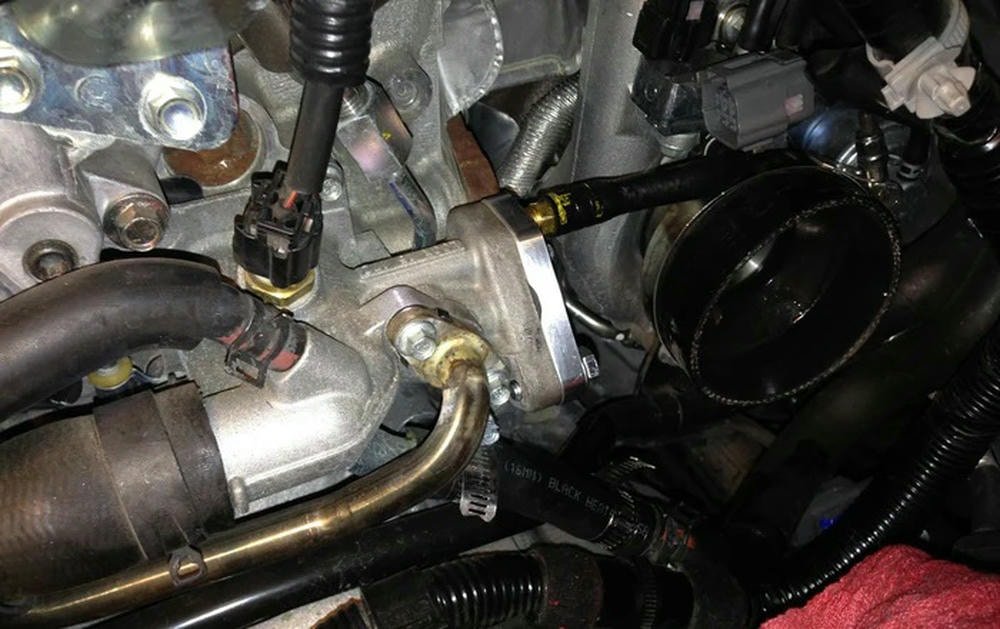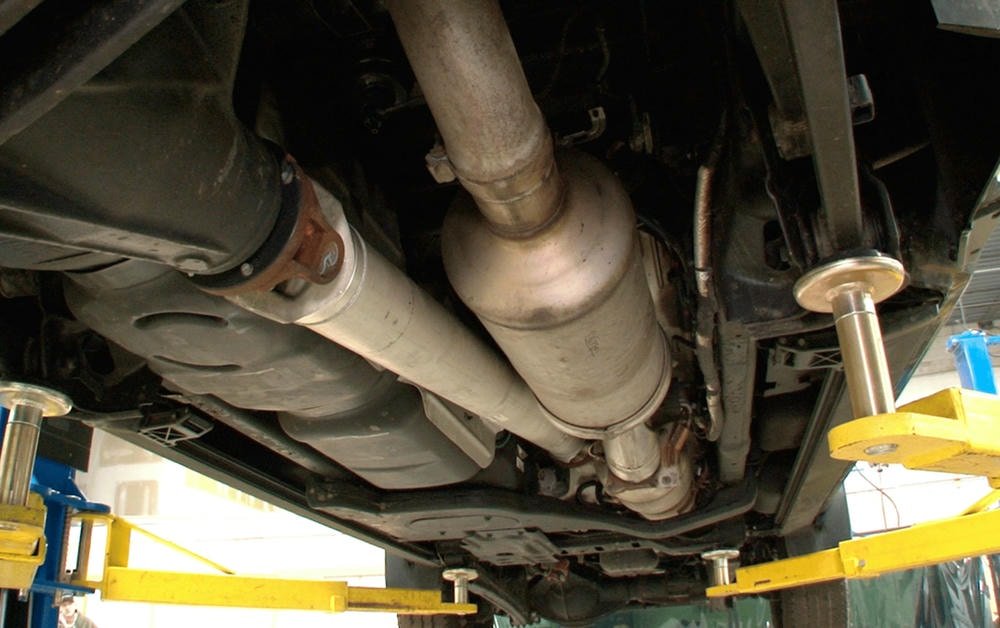Installing a cat-back exhaust system is about making your diesel truck sound better and run more efficiently. This process involves using tools like wrenches, screwdrivers, and jack stands.
Safety comes first. Always wear gloves and safety glasses and work in places with lots of air moving around. Before putting in the new exhaust, you have to take off the old one. Make sure every piece fits well together without gaps or tight spots that could cause problems later.
Testing how the engine works and how the exhaust sounds after installation is also key to ensure everything is right.
People who own diesel trucks often think about this upgrade because it can make their vehicles perform better in terms of power and sound quality. However, picking out the right cat-back system takes careful thought about noise levels, performance gains, costs, and laws.
This guide will walk through each step needed to install a cat-back exhaust from getting ready to test driving after installation while keeping things simple enough for anyone to follow along.
Ready to give your truck an upgrade?
Table of Contents
TogglePreparation for Installation
Getting your tools ready and knowing safety steps is key before starting. Make sure you have wrenches, screwdrivers, and a jack with stands to lift your truck safely.
Required Tools and Equipment
Setting up a cat-back exhaust system on a diesel truck is an exhilarating DIY task. It invigorates engine performance and enriches the sound of the vehicle. Following is a catalog of tools and equipment required for this arrangement:
- Socket set: A variety of sizes are required to dislodge bolts and nuts.
- Wrenches: Adjustable wrenches aid in confined spots where sockets can’t reach.
- Screwdrivers: For slackening clamps or screws securing parts together.
- Jack stands: To securely elevate and support the truck for access below it.
- Hydraulic jack: For the initial elevation of the vehicle off the ground.
- Exhaust hangers: Necessary to adequately fasten the new system in position.
- Saw or cutter: At times, removing old parts is essential; a hacksaw is effective.
- Lubricant spray: Assists in easing rusty or stuck bolts and nuts.
- Rubber mallet: Facilitates in assembling parts together without causing damage.
- Safety gear: Gloves for hand protection and goggles for eye defense from potential harm.
This compilation draws from the encounters of many who have pursued such projects previously, guaranteeing you possess everything necessary for a successful setup.
Safety Precautions
Safety comes first when installing a cat-back exhaust system on a diesel truck. One must wear the right gear, such as gloves and safety glasses, to protect against burns and flying debris.
Keeping a fire extinguisher nearby is wise in case sparks ignite something flammable. Exhaust work often involves cutting or welding, releasing harmful gases like carbon monoxide. So, working in a well-ventilated area is crucial for safety.
Experienced DIYers know that lifting a vehicle requires caution. They use jack stands to securely hold the truck up—never trusting only a jack to keep it lifted. Slipping under an improperly supported vehicle can lead to severe injuries or worse.
Following these precautions helps prevent accidents during the installation of performance exhaust systems, ensuring both personal safety and project success.
Take your time and double-check everything for a safe install.
Vehicle Setup and Pre-installation Checklist
Getting a cat-back exhaust system installed on a diesel truck requires careful preparation. Diesel truck owners should gather the right tools and follow safety steps before starting. Here’s what they need to do:
- Find a flat, stable surface to work on. This ensures the vehicle won’t roll.
- Use wheel chocks behind the wheels for extra security.
- Gather all necessary tools such as wrenches, screwdrivers, and a jack.
- Lift the truck with a hydraulic floor jack. Then, secure it with jack stands.
- Disconnect the battery to prevent any electrical shorts or issues.
- Inspect the existing exhaust system for wear or damage to identify parts that may need extra care during removal.
- Collect new gaskets and clamps if not included with the new exhaust kit.
- Wear safety goggles and gloves to protect against sharp edges and debris.
- Make sure you have enough space around the vehicle to move freely during the installation.
- Check local emissions standards to ensure the new system complies.
This preparation sets diesel truck owners up for a smoother DIY cat-back exhaust installation process by ensuring they have all needed materials and have taken all safety precautions.
Step-by-Step Installation Process
Installing a cat-back exhaust system starts with removing the old parts. This means taking off the current exhaust pipe and muffler. After that, one installs the new mid-pipe and silencer, making sure they’re in place.
Then, they secure the rear exhaust section and tips firmly. The next step is to check everything fits right and make adjustments as needed. Last, a final test ensures all is well with the setup.
This process requires tools like wrenches and screwdrivers, plus knowledge of car mechanics to get it done correctly.
Removing the Old Exhaust System
Removing the old exhaust system is an essential first step before installing a new cat-back setup. Diesel truck owners should raise their vehicle to an adequate height for safe work underneath.
Utilizing jack stands offers the necessary stability and safety. Following this, they should apply penetrating oil to all bolts to facilitate easier removal. This modest action significantly reduces disassembly complications.
Owners then employ wrenches and sockets – common tools for mechanics – to loosen and remove the clamps, screws, and hangers that secure the old exhaust components. At times, parts might be corroded or jammed; patient and cautious force are required here.
Some parts may need to be cut for removal, especially if rust has tightly bonded them.
Each released bolt inches you further to your new exhaust sound.
During this operation, practical knowledge implies maintaining a record of each disassembled part can assist in smoother reassembly – either for returning or installing new pieces.
Installing the Mid-pipe and Muffler
To install the mid-pipe, diesel truck owners need to line up the pipe with the catalytic converter’s end. Using clamps and exhaust hangers helps secure it in place. It’s crucial to make sure every connection is tight and fits well to avoid leaks that can hurt performance.
After attaching the mid-pipe, comes fitting the muffler. This part controls noise and manages engine output sound. Slide the muffler onto the mid-pipe’s end and use more clamps to secure it firmly.
Ensuring everything lines up without forcing parts together keeps your system working right. Check all joins for a snug fit, using adjustments as needed for a perfect alignment. This makes sure your cat-back exhaust works well, boosting your diesel truck’s performance without unwanted noise or rattles.
Securing the Tailpipe and Tips
Securing the tailpipe and tips is a key step in installing a cat-back exhaust system on a diesel truck. First, line up the tailpipe with the rest of the exhaust system. Use clamps to tightly secure it to prevent leaks.
These clamps come as part of your installation kit. Make sure each joint is snug and does not move when pushed or pulled.
Next, attach the exhaust tips at the end of the tailpipe. They often require smaller clamps for a secure fit. Adjust these tips so they extend just beyond your truck’s body, giving it a sleek look while ensuring safety and performance are not compromised.
Keep checking all connections to make sure they stay tight during use.
Checking for Proper Fitment and Adjustments
After installing the cat-back exhaust on a diesel truck, it’s time to check that everything fits right and works well. This step is key for making sure the new system boosts engine performance and sound as expected.
Using a torque wrench, one should go over all bolts and clamps to ensure they’re tight enough according to the manufacturer’s specs. This avoids leaks that could hurt performance. One must also look at how the pipes align, keeping them away from parts of the truck that could melt or get damaged by heat.
A well-adjusted exhaust system speaks volumes about a vehicle’s upkeep.
Inspecting for proper clearance around suspension components, drive shafts, and body panels stops rattles or other noise issues. It’s smart to turn on the engine and listen for any unexpected sounds which might hint at leaks or touches between parts of the exhaust system and truck body.
If everything seems good without strange noises or loose parts, then one has successfully fitted their new cat-back exhaust system right.
Final Testing and Review
Diesel truck owners should run their trucks to test the new cat-back exhaust system. This step checks for leaks and ensures everything fits right. Using a dynamometer, or “dyno,” helps measure engine performance changes.
During this test, listening for unusual sounds is important. These could hint at problems with fitment or leaks.
Many choose to take a short drive as part of the review process. A road test can reveal issues that are not noticeable when the truck is stationary. They keep an eye on how the vehicle handles and any changes in sound or performance from the exhaust modification.
This real-world testing makes sure the diesel truck runs smoothly with its new setup.
Post-Installation Considerations
After putting in a new cat-back exhaust, there are a few key things diesel truck owners need to watch. They should keep an eye out for leaks and make sure everything fits right. Testing the engine’s power and how it sounds is also crucial.
If they notice any issues, they must address them quickly to ensure their truck runs smoothly.
Monitoring for Leaks and Fitment Issues
Keeping an eye out for leaks and fitment issues is crucial after installing a cat-back exhaust system on a diesel truck. A simple way to check for leaks is to run the engine and listen carefully for any unusual sounds, like hissing or whistling, which could signal an escape of gases from the exhaust system.
It’s also wise to use a flashlight and mirror to inspect all connections and joints around the mid-pipe, muffler, tailpipe, and tips. Leaks often occur at these spots if the components aren’t tightly secured.
Fitment problems can lead to rattling noises or parts touching that shouldn’t be. Diesel truck owners should make sure there’s enough clearance between the exhaust parts and any vehicle components.
This prevents heat damage or wear from vibration against other parts under the truck. In their own garage work, one might find adjusting some hangers or clamps gives better alignment of the entire setup, ensuring everything sits just right without stressing any part of the new cat-back exhaust system.
Testing Engine Performance and Sound
After the cat-back exhaust is in place, diesel truck owners should test engine performance and sound. This involves checking how well the engine runs with the new setup. They look for changes in horsepower and torque.
A dynamometer can help measure these changes accurately. This machine shows how much power an engine makes.
They also listen to the sound of their exhaust. The goal is to have a deep, rich tone without it being too loud inside the cab. Some might rev their engines or take their trucks for a drive to hear how it sounds at different speeds.
This way, they ensure their installation improves both performance and sound as desired.
Addressing Any Installation Problems
If a diesel truck owner faces issues after fitting their cat-back exhaust, they should first check for leaks. Leaks in the exhaust pipes or around the mufflers can lower engine performance and increase noise.
They might use soapy water on connections to find any escaping air. Tightening clamps and securing bolts at every connection point is crucial.
For fitment problems, one must ensure the exhaust manifold aligns correctly with the mid-pipe and tailpipe. Sometimes, adjusting hangers or replacing worn-out rubber mounts helps improve alignment and prevents rattling during operation.
Testing engine performance after these adjustments is key to confirm that everything works as it should with the new setup.
Conclusion
Fitting a cat-back exhaust system can make your diesel truck sound and perform better. For such an upgrade, experts like Alex Johnson matter a lot. With years in auto repair, Johnson has seen all kinds of exhaust jobs.
He studied engines at a top tech school and worked on big projects for GMC Sierra and Chevrolet Silverado trucks. His work helps trucks meet smog rules while boosting their power.
Johnson says installing a cat-back exhaust is more than making noise. It’s about better flow from the engine to the tailpipe. This setup uses wide pipes and fewer bends to let exhaust gas out fast.
It leads to more horsepower and torque, especially in turbocharged engines.
Safety stands first for Johnson when upgrading an exhaust system. He reminds us that following laws about emissions is key. Not all setups fit every truck or meet every rule everywhere, he says.
For daily use, he suggests checking how different systems change sound and performance before buying one—balance what you want with what you need legally.
Not all cat-back systems are equal, according to Johnson. Some might give great sound but little performance boost or vice versa. Users should weigh these factors against cost and legal needs.
His final word? A well-chosen cat-back system offers solid value for most diesel truck owners seeking improvement without breaking laws or the bank.
FAQs
What is a cat-back exhaust system and why would I want to install one?
A cat-back exhaust system refers to all the components of an exhaust from the rear of the catalytic converters back. Installing one can enhance your vehicle’s performance, improve engine tuning, and integrate with turbochargers for vehicles like GMC Sierra or Chevrolet Silverado.
How does installing a custom exhaust impact my car’s emissions?
While customizing your car’s exhaust can improve performance, it’s crucial to consider emission regulations. For example, in California, you need to comply with the California Air Resources Board (CARB) rules about nitrogen emissions and oxygen sensors.
Can I do a DIY installation of a cat-back exhaust on my Jeep Wrangler or Dodge Challenger R/T?
Yes! With some basic auto repair tools and a step-by-step guide, you can fit an after-market cat-back exhaust yourself on most cars including Jeep Wrangler or Dodge Challenger R/T.
Does installing a new dual-exhaust affect how catalysts work in my Grand Cherokee?
Installing dual-exhaust systems doesn’t necessarily affect how catalysts work but might require additional adjustments such as scavenging techniques for optimal performance especially if your Grand Cherokee has Hemi engines.
Are there any specific considerations when fitting an aftermarket cat-back system onto cars equipped with carburetors?
When dealing with older models that use carburetors instead of fuel injection systems, keep in mind that changes made downstream at the tailpipe could necessitate adjustments at intake manifolds upstream.
What happens if I don’t properly install oxygen sensors during my DIY setup?
Improper installation of oxygen sensors during your DIY setup may lead to poor fuel economy due to incorrect air-fuel mixture readings being sent to your vehicle’s computer system.


